Lease Accounting: Impact and Challenges
VerifiedAdded on 2020/05/28
|11
|2647
|61
AI Summary
This assignment delves into the implications of the new lease accounting standard. It explores how this standard affects financial reporting, specifically focusing on the recognition of leases on balance sheets and the resulting impact on key financial ratios. The analysis also touches upon the potential challenges organizations might encounter in implementing this new standard, including lobbying efforts from firms with high-level debt and the ethical considerations surrounding window dressing practices.
Contribute Materials
Your contribution can guide someone’s learning journey. Share your
documents today.
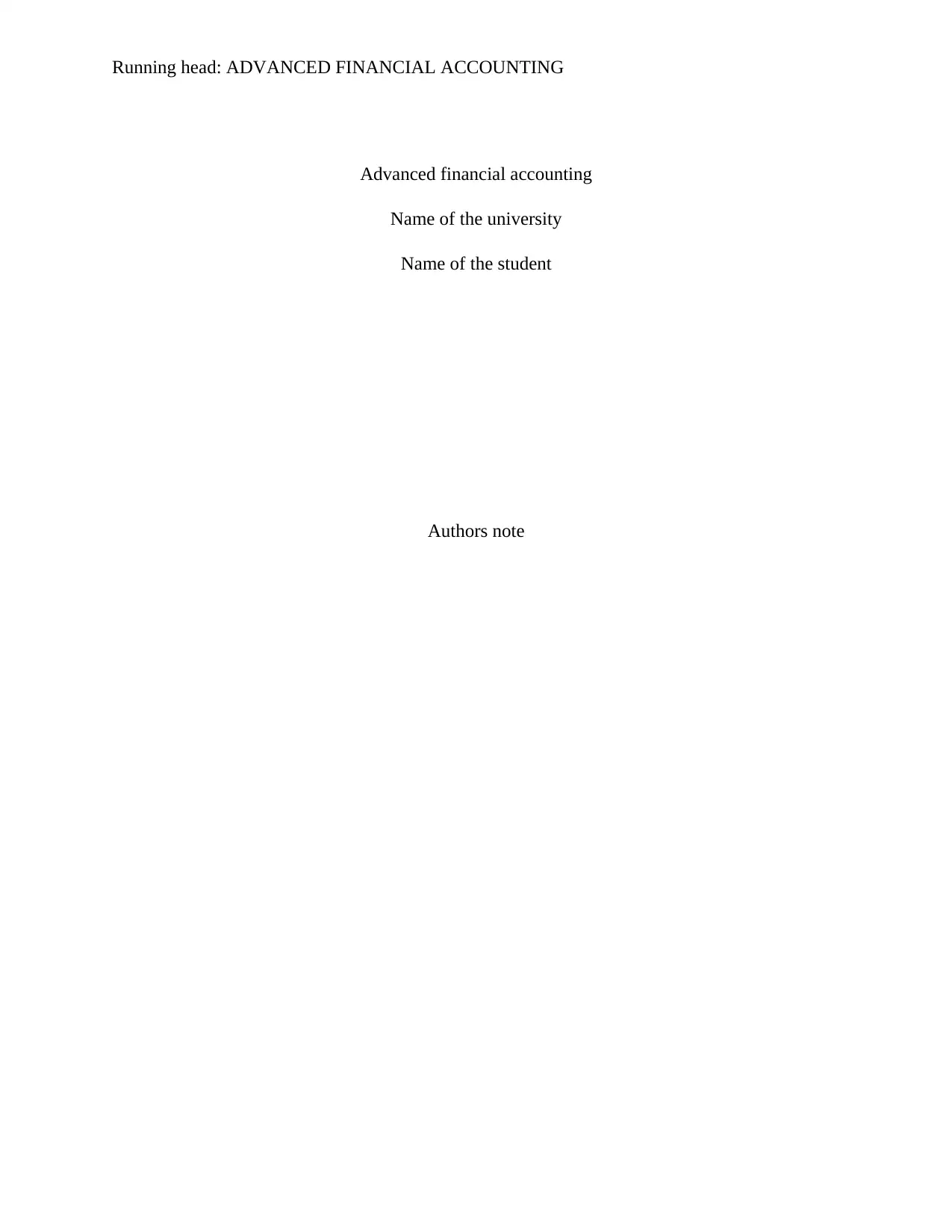
Running head: ADVANCED FINANCIAL ACCOUNTING
Advanced financial accounting
Name of the university
Name of the student
Authors note
Advanced financial accounting
Name of the university
Name of the student
Authors note
Secure Best Marks with AI Grader
Need help grading? Try our AI Grader for instant feedback on your assignments.
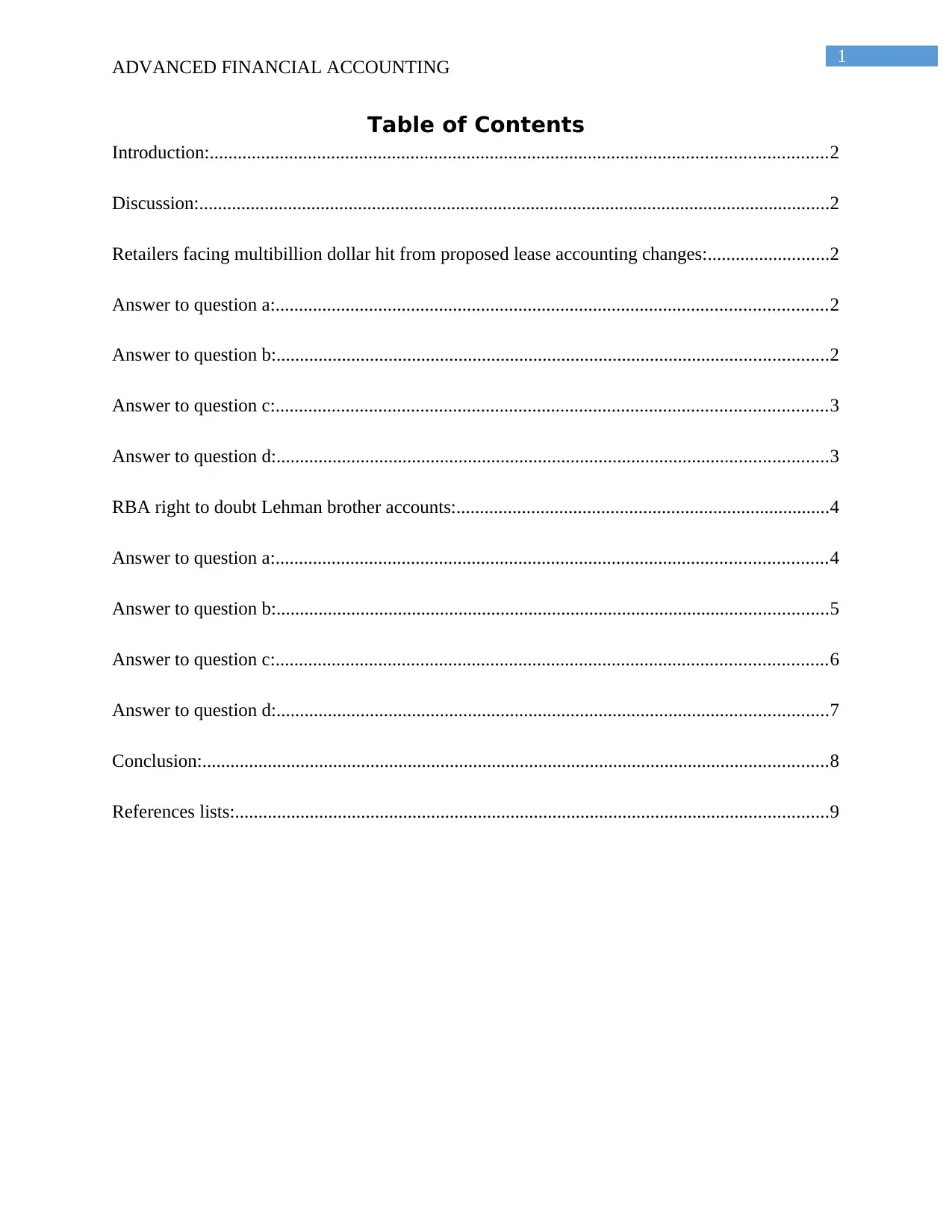
1
ADVANCED FINANCIAL ACCOUNTING
Table of Contents
Introduction:....................................................................................................................................2
Discussion:.......................................................................................................................................2
Retailers facing multibillion dollar hit from proposed lease accounting changes:..........................2
Answer to question a:......................................................................................................................2
Answer to question b:......................................................................................................................2
Answer to question c:......................................................................................................................3
Answer to question d:......................................................................................................................3
RBA right to doubt Lehman brother accounts:................................................................................4
Answer to question a:......................................................................................................................4
Answer to question b:......................................................................................................................5
Answer to question c:......................................................................................................................6
Answer to question d:......................................................................................................................7
Conclusion:......................................................................................................................................8
References lists:...............................................................................................................................9
ADVANCED FINANCIAL ACCOUNTING
Table of Contents
Introduction:....................................................................................................................................2
Discussion:.......................................................................................................................................2
Retailers facing multibillion dollar hit from proposed lease accounting changes:..........................2
Answer to question a:......................................................................................................................2
Answer to question b:......................................................................................................................2
Answer to question c:......................................................................................................................3
Answer to question d:......................................................................................................................3
RBA right to doubt Lehman brother accounts:................................................................................4
Answer to question a:......................................................................................................................4
Answer to question b:......................................................................................................................5
Answer to question c:......................................................................................................................6
Answer to question d:......................................................................................................................7
Conclusion:......................................................................................................................................8
References lists:...............................................................................................................................9
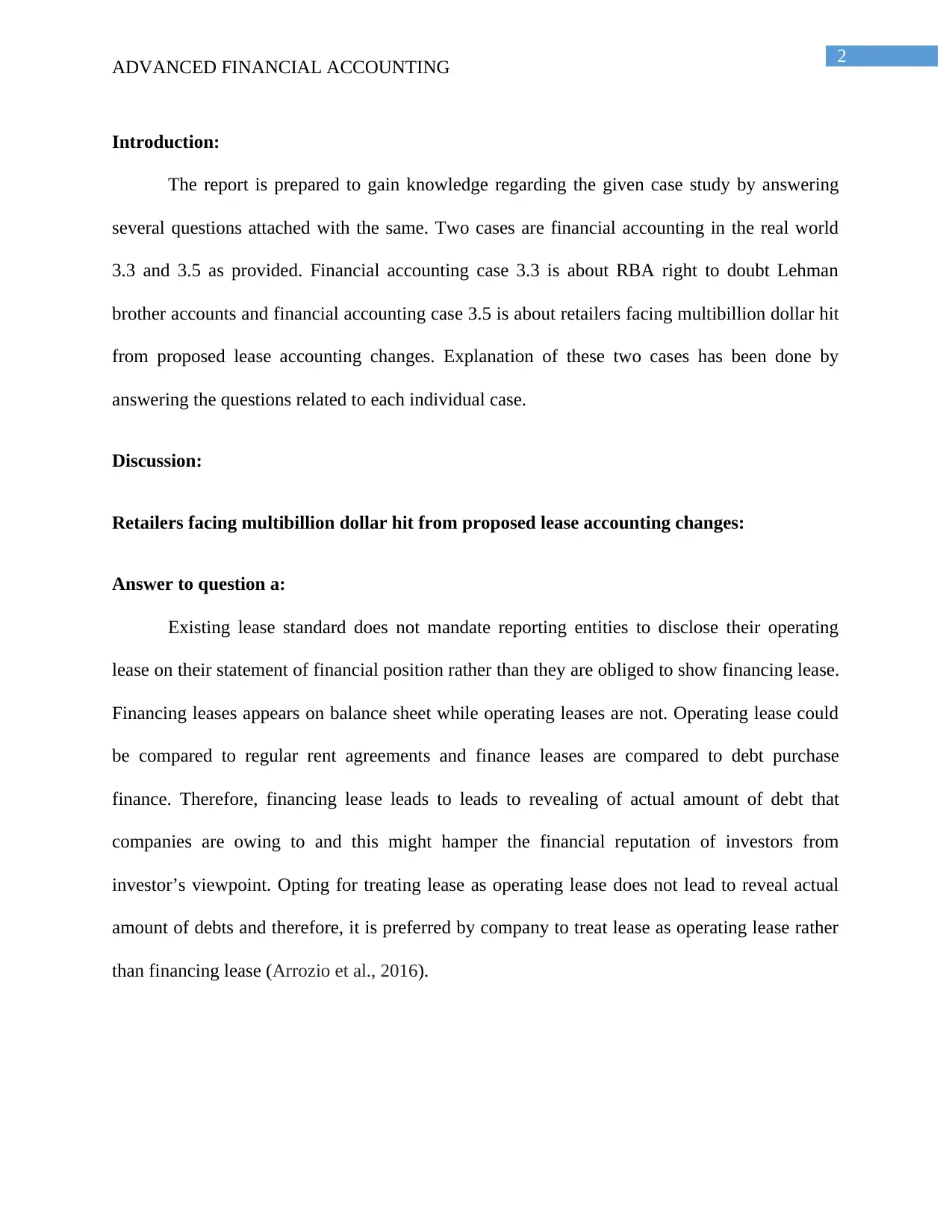
2
ADVANCED FINANCIAL ACCOUNTING
Introduction:
The report is prepared to gain knowledge regarding the given case study by answering
several questions attached with the same. Two cases are financial accounting in the real world
3.3 and 3.5 as provided. Financial accounting case 3.3 is about RBA right to doubt Lehman
brother accounts and financial accounting case 3.5 is about retailers facing multibillion dollar hit
from proposed lease accounting changes. Explanation of these two cases has been done by
answering the questions related to each individual case.
Discussion:
Retailers facing multibillion dollar hit from proposed lease accounting changes:
Answer to question a:
Existing lease standard does not mandate reporting entities to disclose their operating
lease on their statement of financial position rather than they are obliged to show financing lease.
Financing leases appears on balance sheet while operating leases are not. Operating lease could
be compared to regular rent agreements and finance leases are compared to debt purchase
finance. Therefore, financing lease leads to leads to revealing of actual amount of debt that
companies are owing to and this might hamper the financial reputation of investors from
investor’s viewpoint. Opting for treating lease as operating lease does not lead to reveal actual
amount of debts and therefore, it is preferred by company to treat lease as operating lease rather
than financing lease (Arrozio et al., 2016).
ADVANCED FINANCIAL ACCOUNTING
Introduction:
The report is prepared to gain knowledge regarding the given case study by answering
several questions attached with the same. Two cases are financial accounting in the real world
3.3 and 3.5 as provided. Financial accounting case 3.3 is about RBA right to doubt Lehman
brother accounts and financial accounting case 3.5 is about retailers facing multibillion dollar hit
from proposed lease accounting changes. Explanation of these two cases has been done by
answering the questions related to each individual case.
Discussion:
Retailers facing multibillion dollar hit from proposed lease accounting changes:
Answer to question a:
Existing lease standard does not mandate reporting entities to disclose their operating
lease on their statement of financial position rather than they are obliged to show financing lease.
Financing leases appears on balance sheet while operating leases are not. Operating lease could
be compared to regular rent agreements and finance leases are compared to debt purchase
finance. Therefore, financing lease leads to leads to revealing of actual amount of debt that
companies are owing to and this might hamper the financial reputation of investors from
investor’s viewpoint. Opting for treating lease as operating lease does not lead to reveal actual
amount of debts and therefore, it is preferred by company to treat lease as operating lease rather
than financing lease (Arrozio et al., 2016).
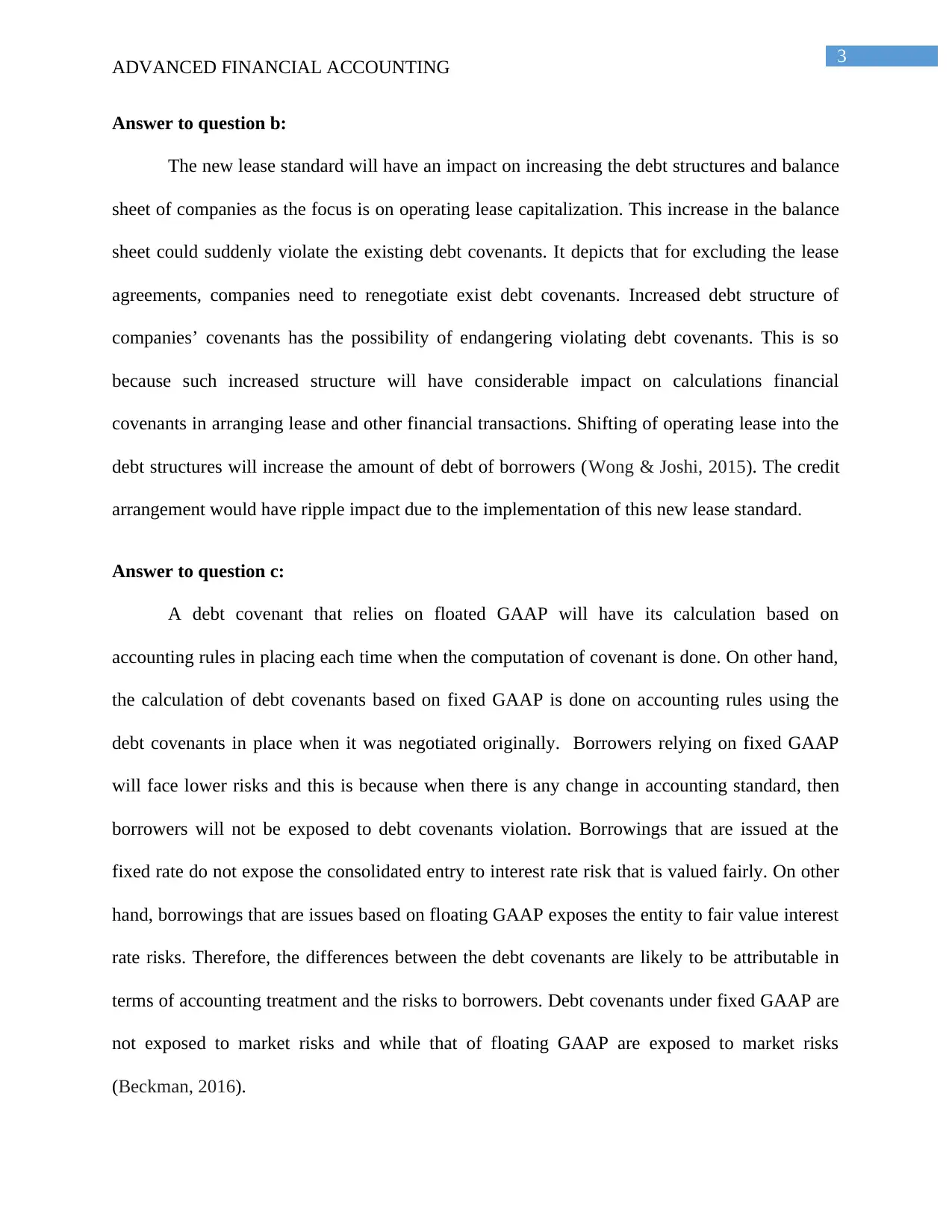
3
ADVANCED FINANCIAL ACCOUNTING
Answer to question b:
The new lease standard will have an impact on increasing the debt structures and balance
sheet of companies as the focus is on operating lease capitalization. This increase in the balance
sheet could suddenly violate the existing debt covenants. It depicts that for excluding the lease
agreements, companies need to renegotiate exist debt covenants. Increased debt structure of
companies’ covenants has the possibility of endangering violating debt covenants. This is so
because such increased structure will have considerable impact on calculations financial
covenants in arranging lease and other financial transactions. Shifting of operating lease into the
debt structures will increase the amount of debt of borrowers (Wong & Joshi, 2015). The credit
arrangement would have ripple impact due to the implementation of this new lease standard.
Answer to question c:
A debt covenant that relies on floated GAAP will have its calculation based on
accounting rules in placing each time when the computation of covenant is done. On other hand,
the calculation of debt covenants based on fixed GAAP is done on accounting rules using the
debt covenants in place when it was negotiated originally. Borrowers relying on fixed GAAP
will face lower risks and this is because when there is any change in accounting standard, then
borrowers will not be exposed to debt covenants violation. Borrowings that are issued at the
fixed rate do not expose the consolidated entry to interest rate risk that is valued fairly. On other
hand, borrowings that are issues based on floating GAAP exposes the entity to fair value interest
rate risks. Therefore, the differences between the debt covenants are likely to be attributable in
terms of accounting treatment and the risks to borrowers. Debt covenants under fixed GAAP are
not exposed to market risks and while that of floating GAAP are exposed to market risks
(Beckman, 2016).
ADVANCED FINANCIAL ACCOUNTING
Answer to question b:
The new lease standard will have an impact on increasing the debt structures and balance
sheet of companies as the focus is on operating lease capitalization. This increase in the balance
sheet could suddenly violate the existing debt covenants. It depicts that for excluding the lease
agreements, companies need to renegotiate exist debt covenants. Increased debt structure of
companies’ covenants has the possibility of endangering violating debt covenants. This is so
because such increased structure will have considerable impact on calculations financial
covenants in arranging lease and other financial transactions. Shifting of operating lease into the
debt structures will increase the amount of debt of borrowers (Wong & Joshi, 2015). The credit
arrangement would have ripple impact due to the implementation of this new lease standard.
Answer to question c:
A debt covenant that relies on floated GAAP will have its calculation based on
accounting rules in placing each time when the computation of covenant is done. On other hand,
the calculation of debt covenants based on fixed GAAP is done on accounting rules using the
debt covenants in place when it was negotiated originally. Borrowers relying on fixed GAAP
will face lower risks and this is because when there is any change in accounting standard, then
borrowers will not be exposed to debt covenants violation. Borrowings that are issued at the
fixed rate do not expose the consolidated entry to interest rate risk that is valued fairly. On other
hand, borrowings that are issues based on floating GAAP exposes the entity to fair value interest
rate risks. Therefore, the differences between the debt covenants are likely to be attributable in
terms of accounting treatment and the risks to borrowers. Debt covenants under fixed GAAP are
not exposed to market risks and while that of floating GAAP are exposed to market risks
(Beckman, 2016).
Secure Best Marks with AI Grader
Need help grading? Try our AI Grader for instant feedback on your assignments.
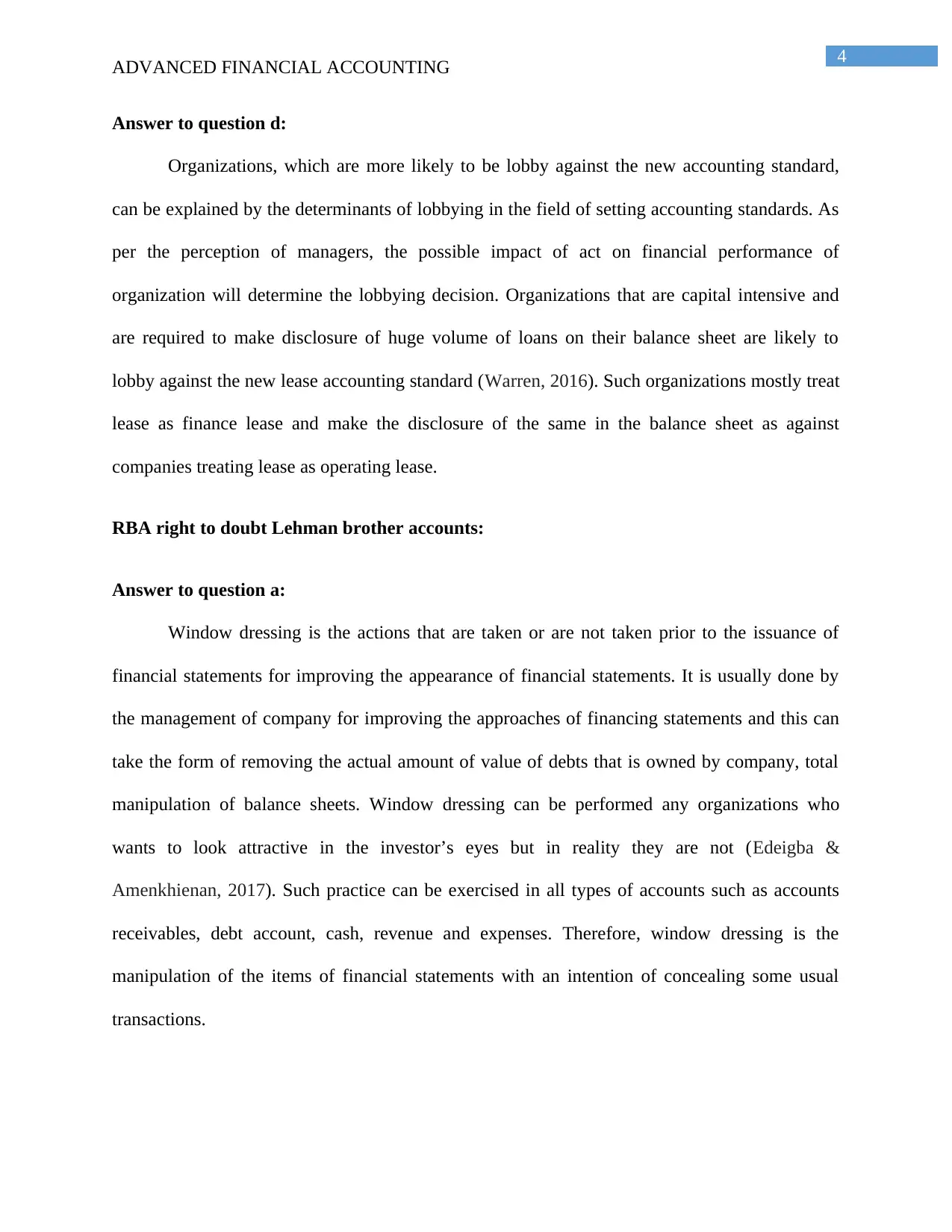
4
ADVANCED FINANCIAL ACCOUNTING
Answer to question d:
Organizations, which are more likely to be lobby against the new accounting standard,
can be explained by the determinants of lobbying in the field of setting accounting standards. As
per the perception of managers, the possible impact of act on financial performance of
organization will determine the lobbying decision. Organizations that are capital intensive and
are required to make disclosure of huge volume of loans on their balance sheet are likely to
lobby against the new lease accounting standard (Warren, 2016). Such organizations mostly treat
lease as finance lease and make the disclosure of the same in the balance sheet as against
companies treating lease as operating lease.
RBA right to doubt Lehman brother accounts:
Answer to question a:
Window dressing is the actions that are taken or are not taken prior to the issuance of
financial statements for improving the appearance of financial statements. It is usually done by
the management of company for improving the approaches of financing statements and this can
take the form of removing the actual amount of value of debts that is owned by company, total
manipulation of balance sheets. Window dressing can be performed any organizations who
wants to look attractive in the investor’s eyes but in reality they are not (Edeigba &
Amenkhienan, 2017). Such practice can be exercised in all types of accounts such as accounts
receivables, debt account, cash, revenue and expenses. Therefore, window dressing is the
manipulation of the items of financial statements with an intention of concealing some usual
transactions.
ADVANCED FINANCIAL ACCOUNTING
Answer to question d:
Organizations, which are more likely to be lobby against the new accounting standard,
can be explained by the determinants of lobbying in the field of setting accounting standards. As
per the perception of managers, the possible impact of act on financial performance of
organization will determine the lobbying decision. Organizations that are capital intensive and
are required to make disclosure of huge volume of loans on their balance sheet are likely to
lobby against the new lease accounting standard (Warren, 2016). Such organizations mostly treat
lease as finance lease and make the disclosure of the same in the balance sheet as against
companies treating lease as operating lease.
RBA right to doubt Lehman brother accounts:
Answer to question a:
Window dressing is the actions that are taken or are not taken prior to the issuance of
financial statements for improving the appearance of financial statements. It is usually done by
the management of company for improving the approaches of financing statements and this can
take the form of removing the actual amount of value of debts that is owned by company, total
manipulation of balance sheets. Window dressing can be performed any organizations who
wants to look attractive in the investor’s eyes but in reality they are not (Edeigba &
Amenkhienan, 2017). Such practice can be exercised in all types of accounts such as accounts
receivables, debt account, cash, revenue and expenses. Therefore, window dressing is the
manipulation of the items of financial statements with an intention of concealing some usual
transactions.
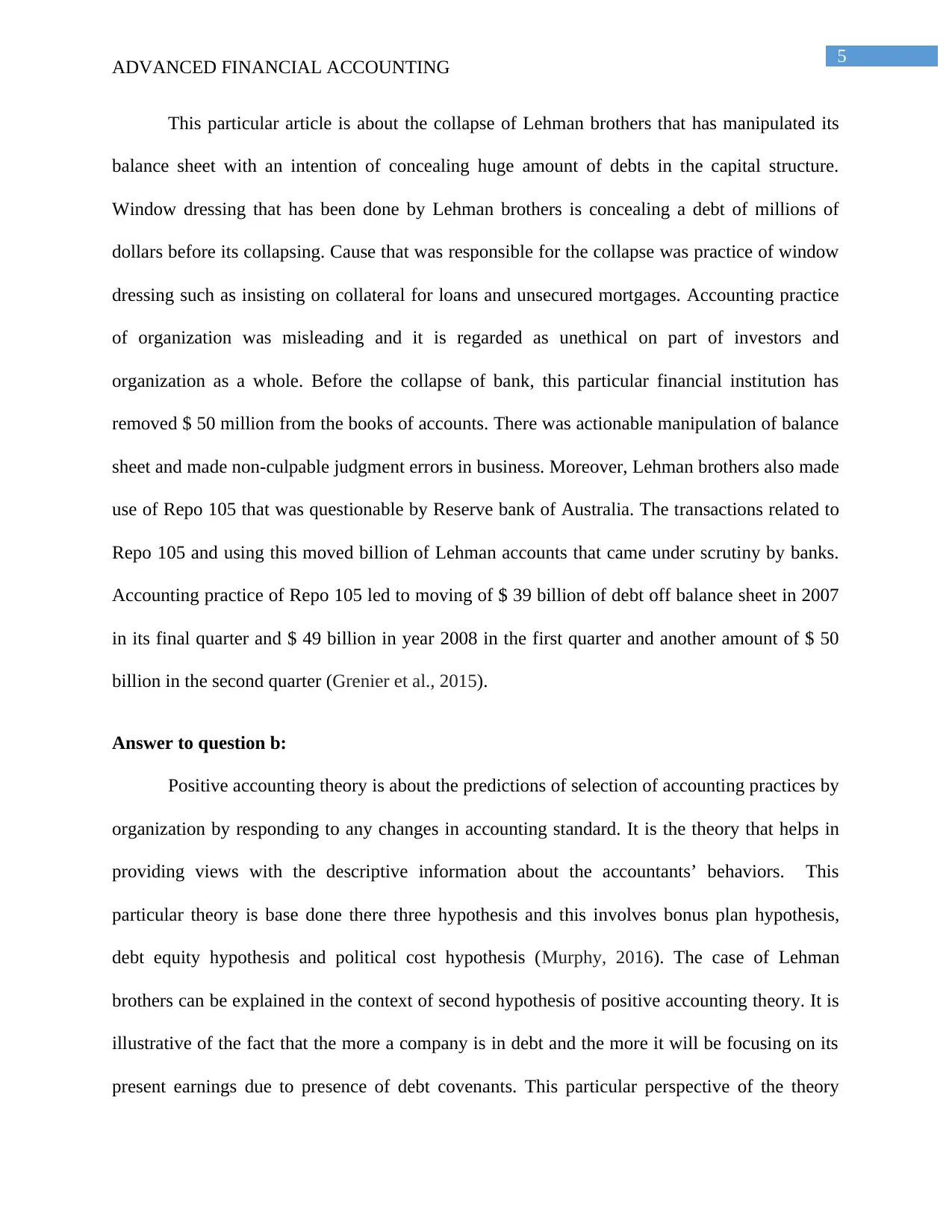
5
ADVANCED FINANCIAL ACCOUNTING
This particular article is about the collapse of Lehman brothers that has manipulated its
balance sheet with an intention of concealing huge amount of debts in the capital structure.
Window dressing that has been done by Lehman brothers is concealing a debt of millions of
dollars before its collapsing. Cause that was responsible for the collapse was practice of window
dressing such as insisting on collateral for loans and unsecured mortgages. Accounting practice
of organization was misleading and it is regarded as unethical on part of investors and
organization as a whole. Before the collapse of bank, this particular financial institution has
removed $ 50 million from the books of accounts. There was actionable manipulation of balance
sheet and made non-culpable judgment errors in business. Moreover, Lehman brothers also made
use of Repo 105 that was questionable by Reserve bank of Australia. The transactions related to
Repo 105 and using this moved billion of Lehman accounts that came under scrutiny by banks.
Accounting practice of Repo 105 led to moving of $ 39 billion of debt off balance sheet in 2007
in its final quarter and $ 49 billion in year 2008 in the first quarter and another amount of $ 50
billion in the second quarter (Grenier et al., 2015).
Answer to question b:
Positive accounting theory is about the predictions of selection of accounting practices by
organization by responding to any changes in accounting standard. It is the theory that helps in
providing views with the descriptive information about the accountants’ behaviors. This
particular theory is base done there three hypothesis and this involves bonus plan hypothesis,
debt equity hypothesis and political cost hypothesis (Murphy, 2016). The case of Lehman
brothers can be explained in the context of second hypothesis of positive accounting theory. It is
illustrative of the fact that the more a company is in debt and the more it will be focusing on its
present earnings due to presence of debt covenants. This particular perspective of the theory
ADVANCED FINANCIAL ACCOUNTING
This particular article is about the collapse of Lehman brothers that has manipulated its
balance sheet with an intention of concealing huge amount of debts in the capital structure.
Window dressing that has been done by Lehman brothers is concealing a debt of millions of
dollars before its collapsing. Cause that was responsible for the collapse was practice of window
dressing such as insisting on collateral for loans and unsecured mortgages. Accounting practice
of organization was misleading and it is regarded as unethical on part of investors and
organization as a whole. Before the collapse of bank, this particular financial institution has
removed $ 50 million from the books of accounts. There was actionable manipulation of balance
sheet and made non-culpable judgment errors in business. Moreover, Lehman brothers also made
use of Repo 105 that was questionable by Reserve bank of Australia. The transactions related to
Repo 105 and using this moved billion of Lehman accounts that came under scrutiny by banks.
Accounting practice of Repo 105 led to moving of $ 39 billion of debt off balance sheet in 2007
in its final quarter and $ 49 billion in year 2008 in the first quarter and another amount of $ 50
billion in the second quarter (Grenier et al., 2015).
Answer to question b:
Positive accounting theory is about the predictions of selection of accounting practices by
organization by responding to any changes in accounting standard. It is the theory that helps in
providing views with the descriptive information about the accountants’ behaviors. This
particular theory is base done there three hypothesis and this involves bonus plan hypothesis,
debt equity hypothesis and political cost hypothesis (Murphy, 2016). The case of Lehman
brothers can be explained in the context of second hypothesis of positive accounting theory. It is
illustrative of the fact that the more a company is in debt and the more it will be focusing on its
present earnings due to presence of debt covenants. This particular perspective of the theory
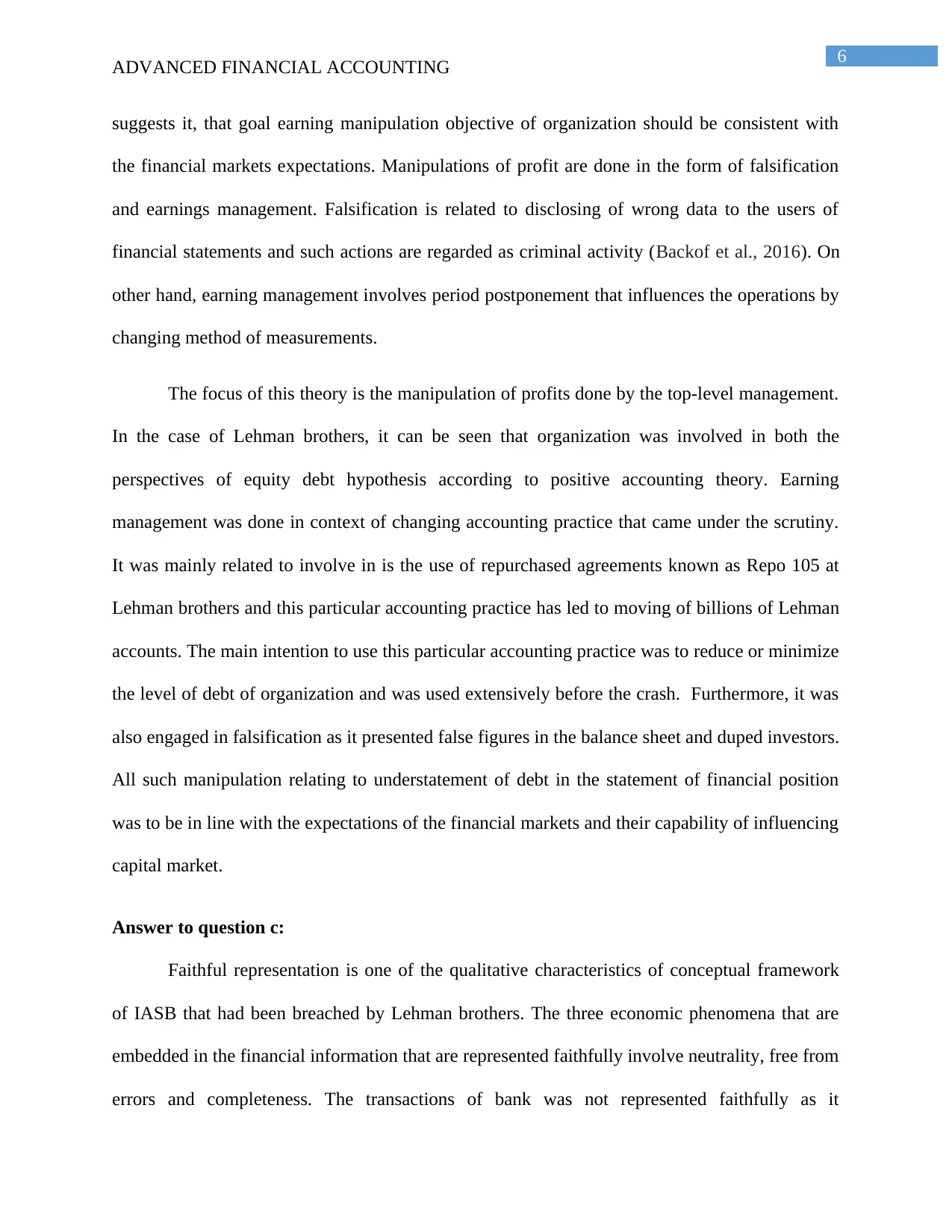
6
ADVANCED FINANCIAL ACCOUNTING
suggests it, that goal earning manipulation objective of organization should be consistent with
the financial markets expectations. Manipulations of profit are done in the form of falsification
and earnings management. Falsification is related to disclosing of wrong data to the users of
financial statements and such actions are regarded as criminal activity (Backof et al., 2016). On
other hand, earning management involves period postponement that influences the operations by
changing method of measurements.
The focus of this theory is the manipulation of profits done by the top-level management.
In the case of Lehman brothers, it can be seen that organization was involved in both the
perspectives of equity debt hypothesis according to positive accounting theory. Earning
management was done in context of changing accounting practice that came under the scrutiny.
It was mainly related to involve in is the use of repurchased agreements known as Repo 105 at
Lehman brothers and this particular accounting practice has led to moving of billions of Lehman
accounts. The main intention to use this particular accounting practice was to reduce or minimize
the level of debt of organization and was used extensively before the crash. Furthermore, it was
also engaged in falsification as it presented false figures in the balance sheet and duped investors.
All such manipulation relating to understatement of debt in the statement of financial position
was to be in line with the expectations of the financial markets and their capability of influencing
capital market.
Answer to question c:
Faithful representation is one of the qualitative characteristics of conceptual framework
of IASB that had been breached by Lehman brothers. The three economic phenomena that are
embedded in the financial information that are represented faithfully involve neutrality, free from
errors and completeness. The transactions of bank was not represented faithfully as it
ADVANCED FINANCIAL ACCOUNTING
suggests it, that goal earning manipulation objective of organization should be consistent with
the financial markets expectations. Manipulations of profit are done in the form of falsification
and earnings management. Falsification is related to disclosing of wrong data to the users of
financial statements and such actions are regarded as criminal activity (Backof et al., 2016). On
other hand, earning management involves period postponement that influences the operations by
changing method of measurements.
The focus of this theory is the manipulation of profits done by the top-level management.
In the case of Lehman brothers, it can be seen that organization was involved in both the
perspectives of equity debt hypothesis according to positive accounting theory. Earning
management was done in context of changing accounting practice that came under the scrutiny.
It was mainly related to involve in is the use of repurchased agreements known as Repo 105 at
Lehman brothers and this particular accounting practice has led to moving of billions of Lehman
accounts. The main intention to use this particular accounting practice was to reduce or minimize
the level of debt of organization and was used extensively before the crash. Furthermore, it was
also engaged in falsification as it presented false figures in the balance sheet and duped investors.
All such manipulation relating to understatement of debt in the statement of financial position
was to be in line with the expectations of the financial markets and their capability of influencing
capital market.
Answer to question c:
Faithful representation is one of the qualitative characteristics of conceptual framework
of IASB that had been breached by Lehman brothers. The three economic phenomena that are
embedded in the financial information that are represented faithfully involve neutrality, free from
errors and completeness. The transactions of bank was not represented faithfully as it
Paraphrase This Document
Need a fresh take? Get an instant paraphrase of this document with our AI Paraphraser
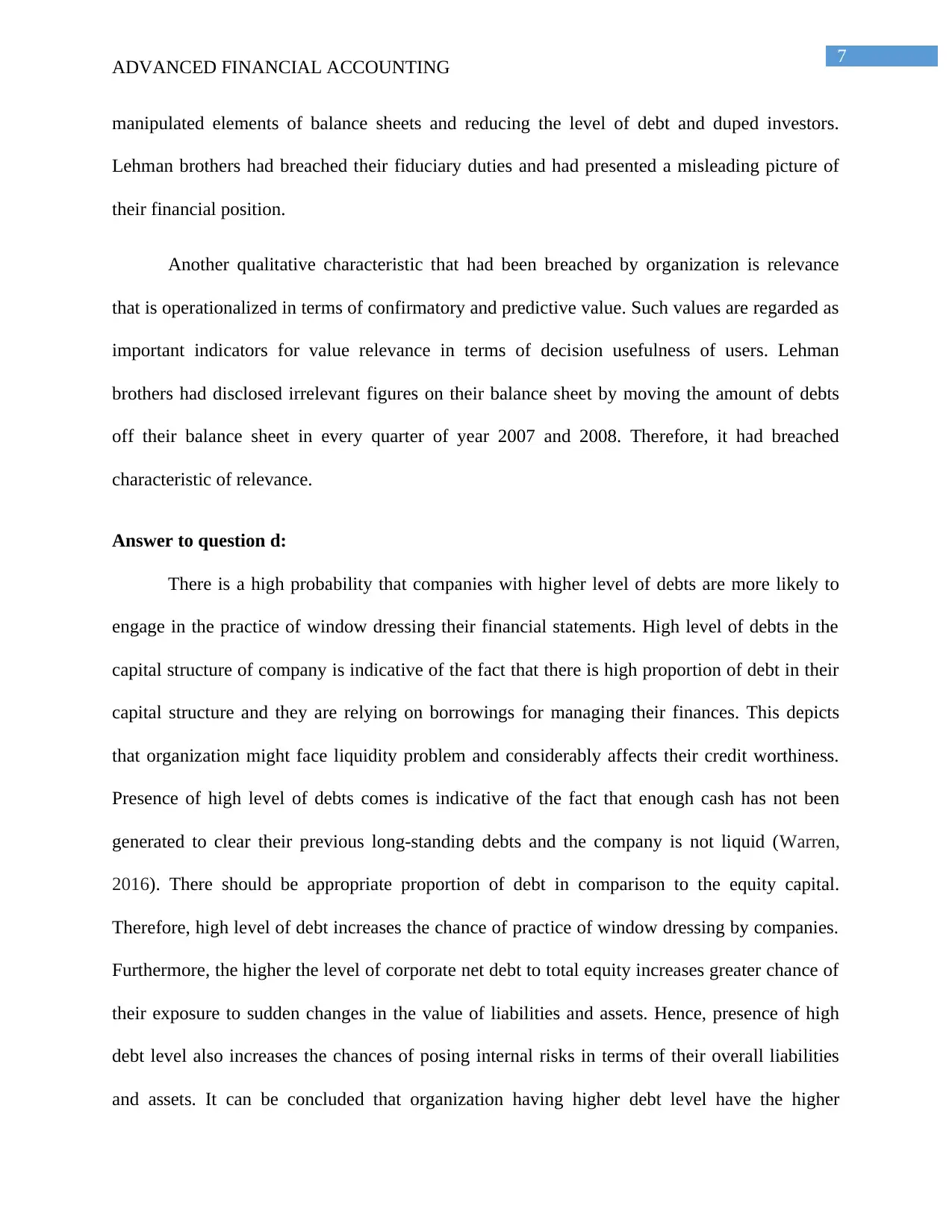
7
ADVANCED FINANCIAL ACCOUNTING
manipulated elements of balance sheets and reducing the level of debt and duped investors.
Lehman brothers had breached their fiduciary duties and had presented a misleading picture of
their financial position.
Another qualitative characteristic that had been breached by organization is relevance
that is operationalized in terms of confirmatory and predictive value. Such values are regarded as
important indicators for value relevance in terms of decision usefulness of users. Lehman
brothers had disclosed irrelevant figures on their balance sheet by moving the amount of debts
off their balance sheet in every quarter of year 2007 and 2008. Therefore, it had breached
characteristic of relevance.
Answer to question d:
There is a high probability that companies with higher level of debts are more likely to
engage in the practice of window dressing their financial statements. High level of debts in the
capital structure of company is indicative of the fact that there is high proportion of debt in their
capital structure and they are relying on borrowings for managing their finances. This depicts
that organization might face liquidity problem and considerably affects their credit worthiness.
Presence of high level of debts comes is indicative of the fact that enough cash has not been
generated to clear their previous long-standing debts and the company is not liquid (Warren,
2016). There should be appropriate proportion of debt in comparison to the equity capital.
Therefore, high level of debt increases the chance of practice of window dressing by companies.
Furthermore, the higher the level of corporate net debt to total equity increases greater chance of
their exposure to sudden changes in the value of liabilities and assets. Hence, presence of high
debt level also increases the chances of posing internal risks in terms of their overall liabilities
and assets. It can be concluded that organization having higher debt level have the higher
ADVANCED FINANCIAL ACCOUNTING
manipulated elements of balance sheets and reducing the level of debt and duped investors.
Lehman brothers had breached their fiduciary duties and had presented a misleading picture of
their financial position.
Another qualitative characteristic that had been breached by organization is relevance
that is operationalized in terms of confirmatory and predictive value. Such values are regarded as
important indicators for value relevance in terms of decision usefulness of users. Lehman
brothers had disclosed irrelevant figures on their balance sheet by moving the amount of debts
off their balance sheet in every quarter of year 2007 and 2008. Therefore, it had breached
characteristic of relevance.
Answer to question d:
There is a high probability that companies with higher level of debts are more likely to
engage in the practice of window dressing their financial statements. High level of debts in the
capital structure of company is indicative of the fact that there is high proportion of debt in their
capital structure and they are relying on borrowings for managing their finances. This depicts
that organization might face liquidity problem and considerably affects their credit worthiness.
Presence of high level of debts comes is indicative of the fact that enough cash has not been
generated to clear their previous long-standing debts and the company is not liquid (Warren,
2016). There should be appropriate proportion of debt in comparison to the equity capital.
Therefore, high level of debt increases the chance of practice of window dressing by companies.
Furthermore, the higher the level of corporate net debt to total equity increases greater chance of
their exposure to sudden changes in the value of liabilities and assets. Hence, presence of high
debt level also increases the chances of posing internal risks in terms of their overall liabilities
and assets. It can be concluded that organization having higher debt level have the higher
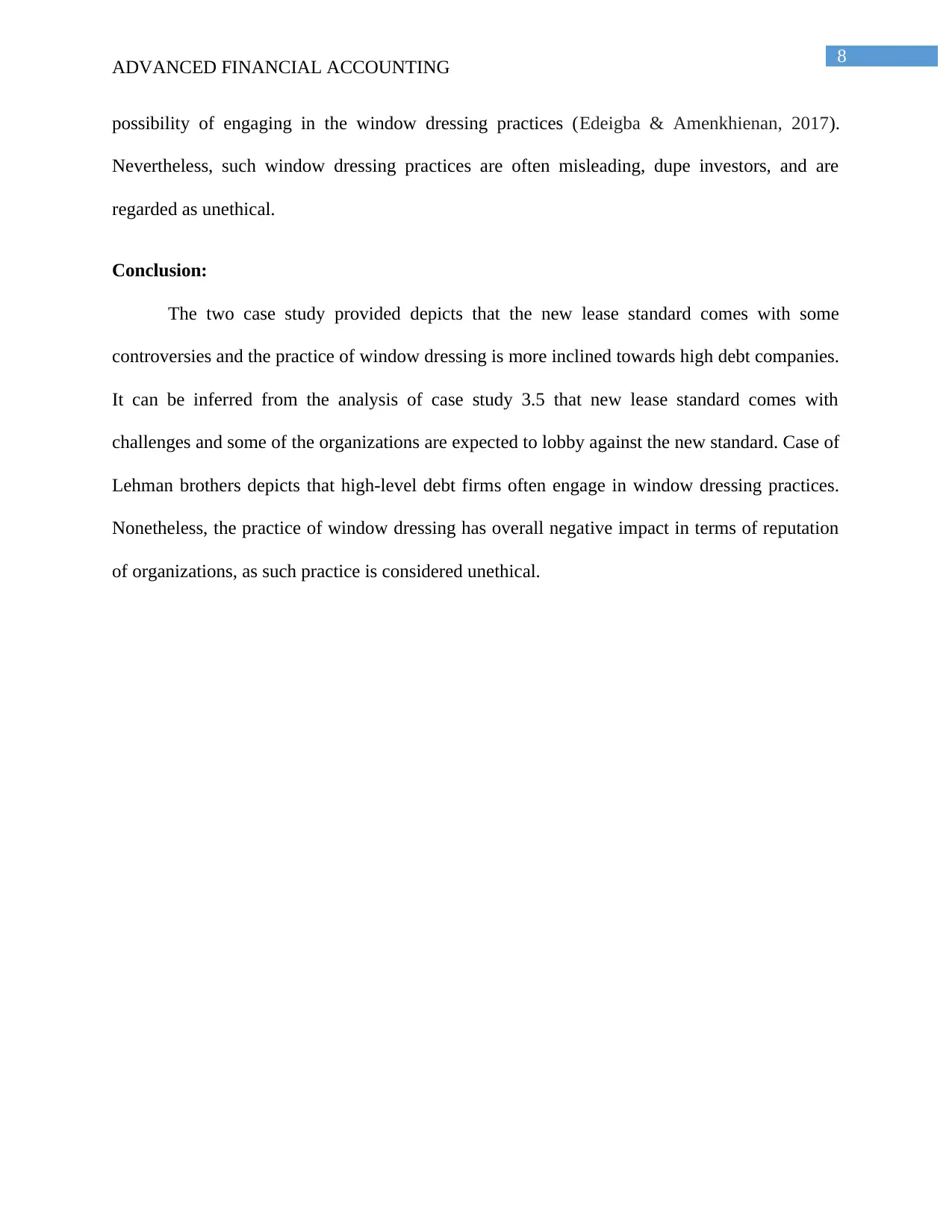
8
ADVANCED FINANCIAL ACCOUNTING
possibility of engaging in the window dressing practices (Edeigba & Amenkhienan, 2017).
Nevertheless, such window dressing practices are often misleading, dupe investors, and are
regarded as unethical.
Conclusion:
The two case study provided depicts that the new lease standard comes with some
controversies and the practice of window dressing is more inclined towards high debt companies.
It can be inferred from the analysis of case study 3.5 that new lease standard comes with
challenges and some of the organizations are expected to lobby against the new standard. Case of
Lehman brothers depicts that high-level debt firms often engage in window dressing practices.
Nonetheless, the practice of window dressing has overall negative impact in terms of reputation
of organizations, as such practice is considered unethical.
ADVANCED FINANCIAL ACCOUNTING
possibility of engaging in the window dressing practices (Edeigba & Amenkhienan, 2017).
Nevertheless, such window dressing practices are often misleading, dupe investors, and are
regarded as unethical.
Conclusion:
The two case study provided depicts that the new lease standard comes with some
controversies and the practice of window dressing is more inclined towards high debt companies.
It can be inferred from the analysis of case study 3.5 that new lease standard comes with
challenges and some of the organizations are expected to lobby against the new standard. Case of
Lehman brothers depicts that high-level debt firms often engage in window dressing practices.
Nonetheless, the practice of window dressing has overall negative impact in terms of reputation
of organizations, as such practice is considered unethical.
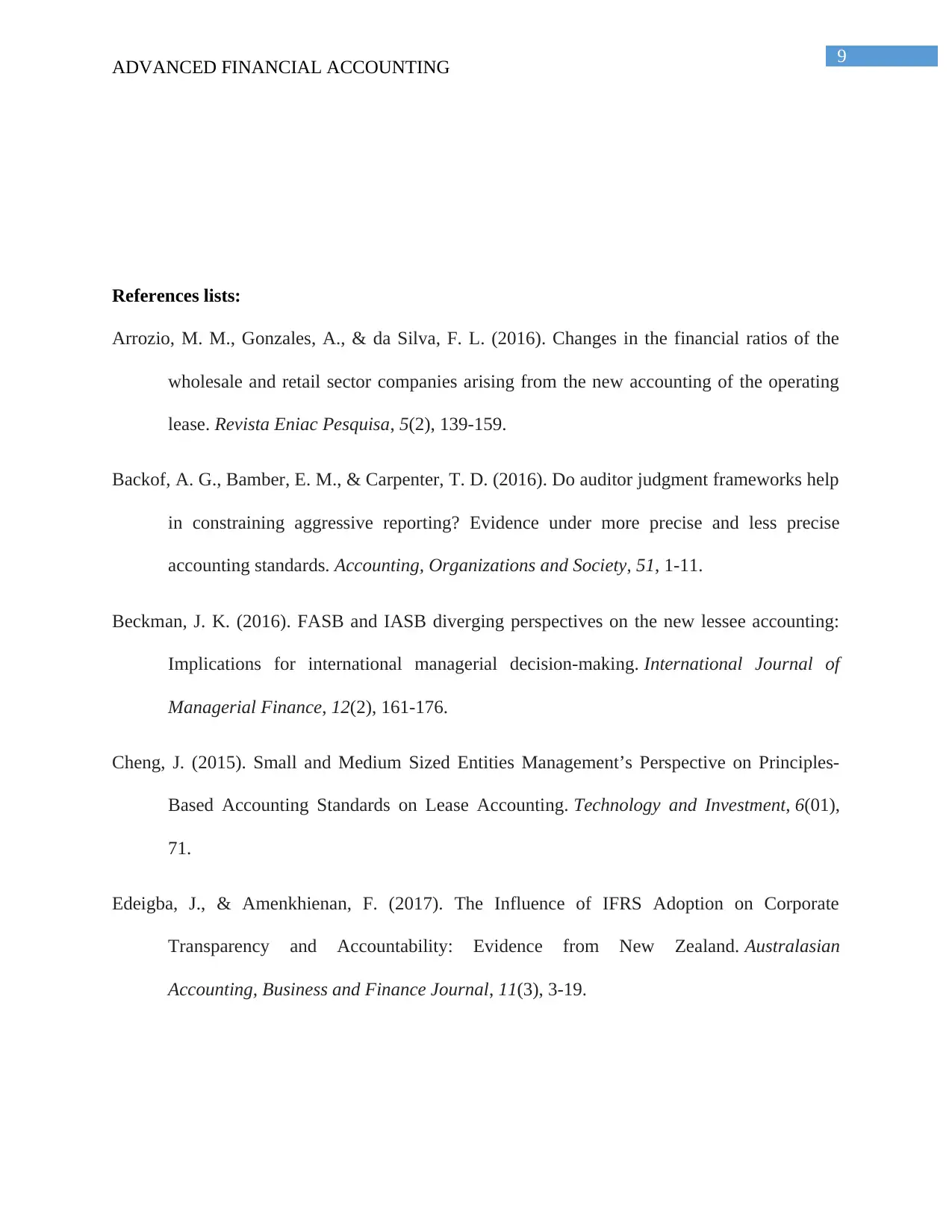
9
ADVANCED FINANCIAL ACCOUNTING
References lists:
Arrozio, M. M., Gonzales, A., & da Silva, F. L. (2016). Changes in the financial ratios of the
wholesale and retail sector companies arising from the new accounting of the operating
lease. Revista Eniac Pesquisa, 5(2), 139-159.
Backof, A. G., Bamber, E. M., & Carpenter, T. D. (2016). Do auditor judgment frameworks help
in constraining aggressive reporting? Evidence under more precise and less precise
accounting standards. Accounting, Organizations and Society, 51, 1-11.
Beckman, J. K. (2016). FASB and IASB diverging perspectives on the new lessee accounting:
Implications for international managerial decision-making. International Journal of
Managerial Finance, 12(2), 161-176.
Cheng, J. (2015). Small and Medium Sized Entities Management’s Perspective on Principles-
Based Accounting Standards on Lease Accounting. Technology and Investment, 6(01),
71.
Edeigba, J., & Amenkhienan, F. (2017). The Influence of IFRS Adoption on Corporate
Transparency and Accountability: Evidence from New Zealand. Australasian
Accounting, Business and Finance Journal, 11(3), 3-19.
ADVANCED FINANCIAL ACCOUNTING
References lists:
Arrozio, M. M., Gonzales, A., & da Silva, F. L. (2016). Changes in the financial ratios of the
wholesale and retail sector companies arising from the new accounting of the operating
lease. Revista Eniac Pesquisa, 5(2), 139-159.
Backof, A. G., Bamber, E. M., & Carpenter, T. D. (2016). Do auditor judgment frameworks help
in constraining aggressive reporting? Evidence under more precise and less precise
accounting standards. Accounting, Organizations and Society, 51, 1-11.
Beckman, J. K. (2016). FASB and IASB diverging perspectives on the new lessee accounting:
Implications for international managerial decision-making. International Journal of
Managerial Finance, 12(2), 161-176.
Cheng, J. (2015). Small and Medium Sized Entities Management’s Perspective on Principles-
Based Accounting Standards on Lease Accounting. Technology and Investment, 6(01),
71.
Edeigba, J., & Amenkhienan, F. (2017). The Influence of IFRS Adoption on Corporate
Transparency and Accountability: Evidence from New Zealand. Australasian
Accounting, Business and Finance Journal, 11(3), 3-19.
Secure Best Marks with AI Grader
Need help grading? Try our AI Grader for instant feedback on your assignments.
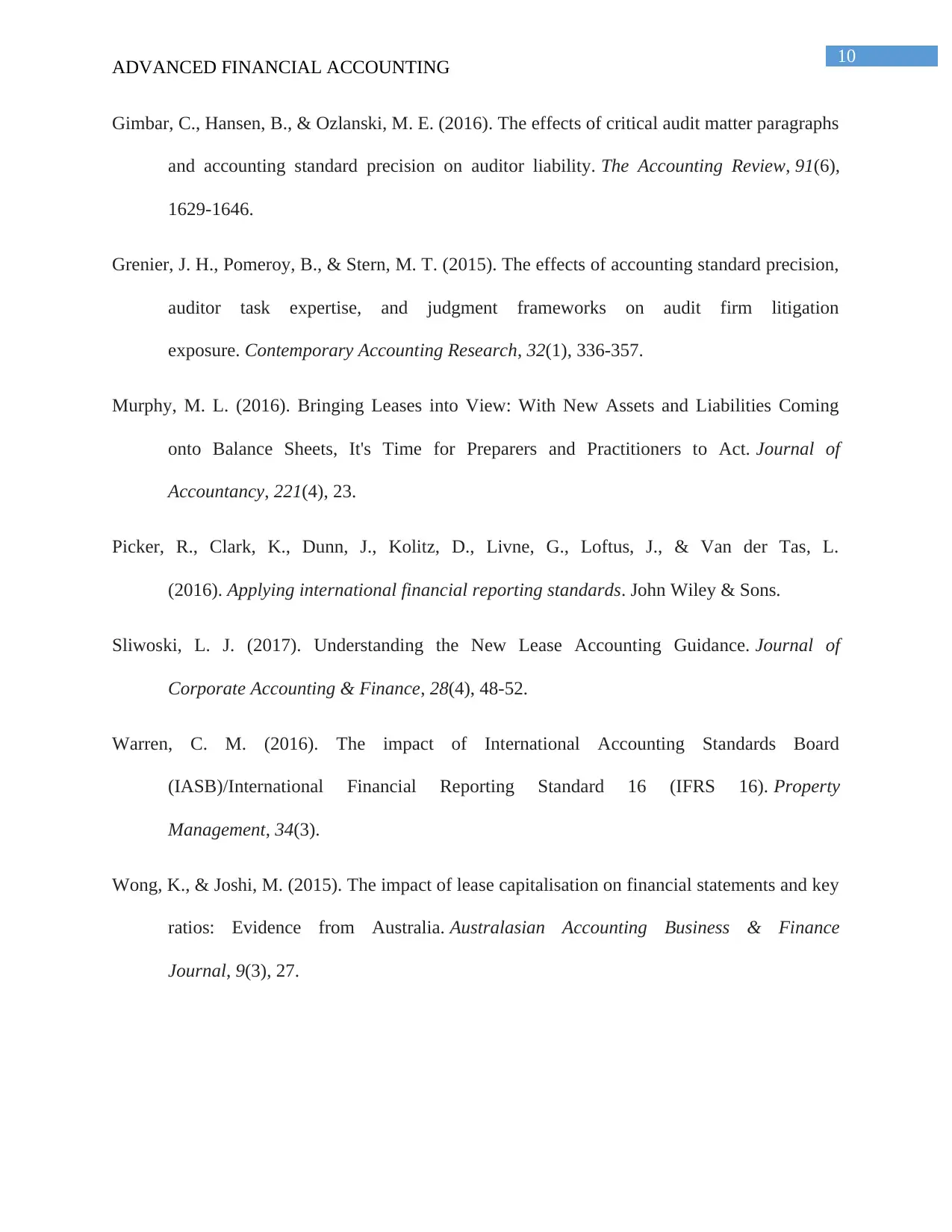
10
ADVANCED FINANCIAL ACCOUNTING
Gimbar, C., Hansen, B., & Ozlanski, M. E. (2016). The effects of critical audit matter paragraphs
and accounting standard precision on auditor liability. The Accounting Review, 91(6),
1629-1646.
Grenier, J. H., Pomeroy, B., & Stern, M. T. (2015). The effects of accounting standard precision,
auditor task expertise, and judgment frameworks on audit firm litigation
exposure. Contemporary Accounting Research, 32(1), 336-357.
Murphy, M. L. (2016). Bringing Leases into View: With New Assets and Liabilities Coming
onto Balance Sheets, It's Time for Preparers and Practitioners to Act. Journal of
Accountancy, 221(4), 23.
Picker, R., Clark, K., Dunn, J., Kolitz, D., Livne, G., Loftus, J., & Van der Tas, L.
(2016). Applying international financial reporting standards. John Wiley & Sons.
Sliwoski, L. J. (2017). Understanding the New Lease Accounting Guidance. Journal of
Corporate Accounting & Finance, 28(4), 48-52.
Warren, C. M. (2016). The impact of International Accounting Standards Board
(IASB)/International Financial Reporting Standard 16 (IFRS 16). Property
Management, 34(3).
Wong, K., & Joshi, M. (2015). The impact of lease capitalisation on financial statements and key
ratios: Evidence from Australia. Australasian Accounting Business & Finance
Journal, 9(3), 27.
ADVANCED FINANCIAL ACCOUNTING
Gimbar, C., Hansen, B., & Ozlanski, M. E. (2016). The effects of critical audit matter paragraphs
and accounting standard precision on auditor liability. The Accounting Review, 91(6),
1629-1646.
Grenier, J. H., Pomeroy, B., & Stern, M. T. (2015). The effects of accounting standard precision,
auditor task expertise, and judgment frameworks on audit firm litigation
exposure. Contemporary Accounting Research, 32(1), 336-357.
Murphy, M. L. (2016). Bringing Leases into View: With New Assets and Liabilities Coming
onto Balance Sheets, It's Time for Preparers and Practitioners to Act. Journal of
Accountancy, 221(4), 23.
Picker, R., Clark, K., Dunn, J., Kolitz, D., Livne, G., Loftus, J., & Van der Tas, L.
(2016). Applying international financial reporting standards. John Wiley & Sons.
Sliwoski, L. J. (2017). Understanding the New Lease Accounting Guidance. Journal of
Corporate Accounting & Finance, 28(4), 48-52.
Warren, C. M. (2016). The impact of International Accounting Standards Board
(IASB)/International Financial Reporting Standard 16 (IFRS 16). Property
Management, 34(3).
Wong, K., & Joshi, M. (2015). The impact of lease capitalisation on financial statements and key
ratios: Evidence from Australia. Australasian Accounting Business & Finance
Journal, 9(3), 27.
1 out of 11
Your All-in-One AI-Powered Toolkit for Academic Success.
+13062052269
info@desklib.com
Available 24*7 on WhatsApp / Email
![[object Object]](/_next/static/media/star-bottom.7253800d.svg)
Unlock your academic potential
© 2024 | Zucol Services PVT LTD | All rights reserved.



